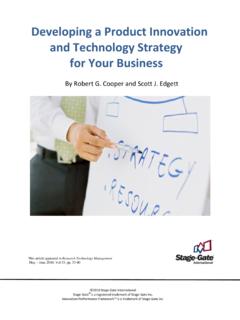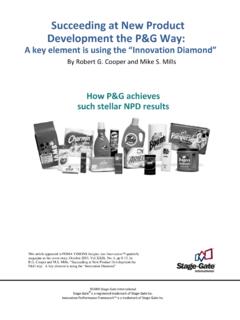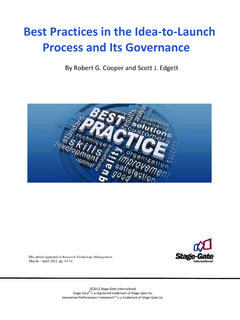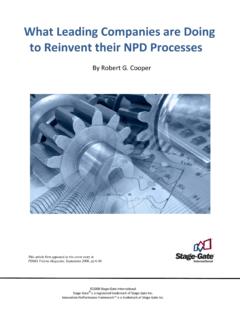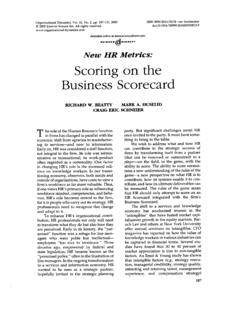Transcription of The seven principles of the latest Stage-Gate …
1 18 MM March/April 2006 The seven principles of the latest Stage-Gate method add upto a streamlined, new-productidea-to-launch process. BY ROBERT G. COOPER you ever wondered whysome companies make productinnovation seem so easy gener-ating one big winner after another? Here isa startling fact: New-product development(NPD) productivity in the top performingcompany is five times what it is in theaverage company. The top performer getsfive times as much new-product output forthe same investment, according to theInnovation Excellence Study 2005conductedby Arthur D.
2 Little (ADL). For the rest ofus, developing a steady stream of success-ful new products is a real Productivity GapsThe concept of productivity is simple:the most bang for the buck. In productdevelopment, it is output (new-productsales or profits) divided by input (researchand development or NPD costs and time). The ADL study provides insights intoNPD productivity by industry. It looks atoutput (five-year sales from new productsas a percentage of company sales) andinput (research and development spendingas a percentage of company sales).
3 Onestartling conclusion is the difference in productivity between top performers andthe rest, regardless of industry. On aver-age, there s an almost 1,200% differencebetween the most productive (top 25% of companies on this metric) and least productive (bottom 25% of companies onthis metric). And in some industries, thedifference is even greater. For example, the top 25% pharmaceutical companies are 31 times more productive in NPD than the bottom 25%. What are these high productivity companies doing so differently, and can your company learnfrom them?
4 2000-2012 Product Development Institute Inc. Product Development Institute Inc. and Stage-Gate International are registered trademarks. ProductivitySeven key principles of lean, rapid, and profitable NPD arecommon denominators of high productivity businesses inproduct innovation . They are very much fact-based and wereuncovered in benchmarking and best practice studies of topperforming companies. These principles were developed froma long tradition of solid research, culminating in the mostrecent American Productivity & Quality Center (APQC) studyof best practices in product innovation .
5 Our research showsthat companies or project teams that employ these principlesachieve superior performance results, and that poor perform-ers tend to ignore them (see Exhibit 1). Integrating the follow-ing principles of NPD into your new-product methodologyresults in a next generation idea-to-launch process, or NexGenStage-Gate . ( Stage-Gate is a registered trademark of theProduct Development Institute Inc.)Customer and delivering new prod-ucts that are differentiated, solve major customer problems,and offer a compelling value propositionto the customer are the top drivers ofNPD success and profitability.
6 The prod-uct or service must possess a wow fac-tor or a little excitement, something thatis missing from most new products. Butconceiving such a product seems beyondthe reach of many companies. Indeed, amajor reason for the decline in NPDproductivity is that many companypipelines simply lack stimulating andgenuine new products. Instead, they arefocused on tweaks, modifications, andextensions with little real quest for unique, superior prod-ucts begins with a thorough understand-ing of the customer s unmet and oftenunarticulated needs through in-the-field, voice-of-customer work.
7 This meansthat the entire team technical, market-ing, and operations people interviewsand interfaces with real customers/users,and learns their problems, needs, andchallenges firsthand. This is quite differ-ent from relying on the salesperson or product manager tospeak for the marketplace; such information is often filtered,biased, and incorrect. The result is that the customer becomesan integral part of the entire process: scoping, product defini-tion, development, validation, and diligence in the early days of aproject pays off; just ask a venture capitalist.
8 A good dose ofthe right up-front homework pays for itself tenfold, savingtime and producing higher success rates. Smart managersdemand such preparation on projects: fact-based market, tech-nical, and business assessments. This homework is not exces-sive; rather, it yields just enough vital information for makingthe go-to-development decision, and for sufficiently definingthe product and project to proceed. It s also instrumental ingenerating a winning development. Things change. Often a team chargesinto development with a product definition based on informa-tion that was right at the time, or thought to be right.
9 But itMany businesses use the Stage-Gate process which this author introduced in 1988 toconceive, develop, and launch new products. As proficient companies have implemented, mod-ified, adapted, and improved the methodology, it has morphed into a faster, leaner, and moreeffective tool. The next generation process, or NexGen Stage-Gate , builds in seven principles of lean, rapid, and profitablenew-product development to maximize productivity in product Customer focused2. Heavy front-end homework before development begins3.
10 Spiral development loops with users throughout development4. Holistic effective cross-functional teams5. Metrics, accountable teams, profit/loss reports for continuous learning6. Focus and porfolio management 7. Lean, scalable, and adaptable Stage-Gate process0% 10% 20% 30% 40%50% 60% 70%80% 90% 100%Percentage of of data: APQC study Exhibit 1 High productivity businesses practice the seven NPD principles Low productivity businesses Average productivity businesses High productivity businesses 2000-2012 Product Development Institute Inc.
